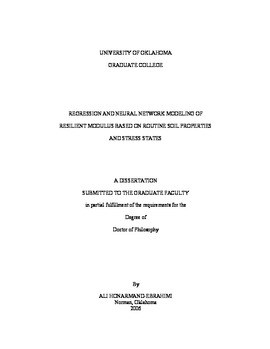| dc.contributor.advisor | Zaman, Musharraf, | en_US |
| dc.contributor.author | Honarmand-ebrahimi, Ali. | en_US |
| dc.date.accessioned | 2013-08-16T12:20:26Z | |
| dc.date.available | 2013-08-16T12:20:26Z | |
| dc.date.issued | 2006 | en_US |
| dc.identifier.uri | https://hdl.handle.net/11244/1116 | |
| dc.description.abstract | The laboratory results from the fourteen sites from fourteen counties were used to develop the relationships or models. | en_US |
| dc.description.abstract | In order to illustrate the application of the developed model, the AASHTO flexible pavement design methodology was used to design asphalt concrete pavement sections. The design MR values from three soil specimens from the evaluation dataset were calculated from the MLPN-2 model. The pavement sections determined from the experimental MR values were compared with the pavement sections determined from the MR values predicted by the MLPN-2 model. (Abstract shortened by UMI.) | en_US |
| dc.description.abstract | Based on the ODOT specifications, two specimens were prepared and tested for resilient modulus (MR) for each soil. One of the MR specimens was prepared at the Optimum Moisture Content (OMC) and 95% of the maximum dry density, while the other specimen was prepared at maximum dry density and 2% wet of the OMC. This yielded one hundred twenty six M R specimens tests for the development dataset. The MR test results were evaluated for quality assurance. | en_US |
| dc.description.abstract | Sixty-three (63) soil samples from fourteen (14) different sites throughout Oklahoma were collected and tested for the development of the database and the statistical models and the ANN models. | en_US |
| dc.description.abstract | A more complex modeling technique, Artificial Neural Network (ANN), was employed. Six different models were considered in this phase, namely, Linear Network (LN), Generalized Regression Neural Networks (GRNN), Radial Basic Function Networks (RBFN), and Multi-Layer Perceptrons Networks (MLPN) with one, two and three hidden layers (MLPN-1, MLPN-2, and MLPN-3). | en_US |
| dc.description.abstract | The routine material parameters selected in the development of the models include moisture content (w), dry density (gammad), plasticity index (PI), percent passing No. 200 sieve (P200), and unconfined compressive strength (Uc). | en_US |
| dc.description.abstract | Resilient modulus (MR) is one of the fundamental material properties in the mechanistic analysis and structural design of roadway pavements. In the current and the proposed mechanistic-empirical design guides by AASHTO, MR is used to characterize subgrade soils. To this end, a combined laboratory and modeling study was undertaken to develop a database for subgrade soils in Oklahoma and to develop relationships or models that could be used to estimate MR from commonly used subgrade soil properties in Oklahoma. Specifically, two categories of models, namely statistical models and Artificial Neural Network (ANN) models, are employed for the determination of M R based on routine laboratory test results. | en_US |
| dc.format.extent | xxv, 385 leaves : | en_US |
| dc.subject | Road materials Testing. | en_US |
| dc.subject | Pavements, Flexible Oklahoma. | en_US |
| dc.subject | Soil mechanics Oklahoma. | en_US |
| dc.subject | Engineering, Civil. | en_US |
| dc.title | Regression and neural network modeling of resilient modulus based on routine soil properties and stress states. | en_US |
| dc.type | Thesis | en_US |
| dc.thesis.degree | Ph.D. | en_US |
| dc.thesis.degreeDiscipline | School of Civil Engineering and Environmental Science | en_US |
| dc.note | Source: Dissertation Abstracts International, Volume: 67-10, Section: B, page: 5915. | en_US |
| dc.note | Adviser: Musharraf Zaman. | en_US |
| ou.identifier | (UMI)AAI3238559 | en_US |
| ou.group | College of Engineering::School of Civil Engineering and Environmental Science | |
